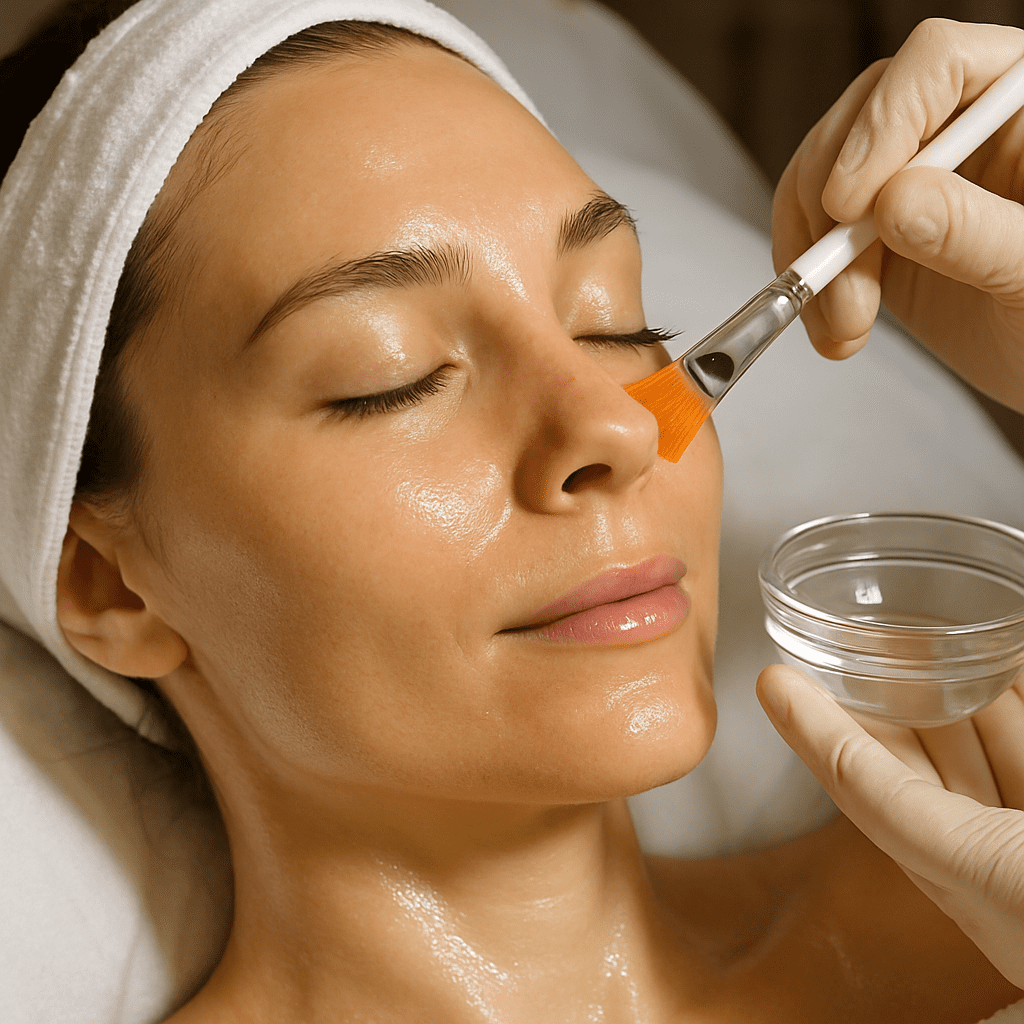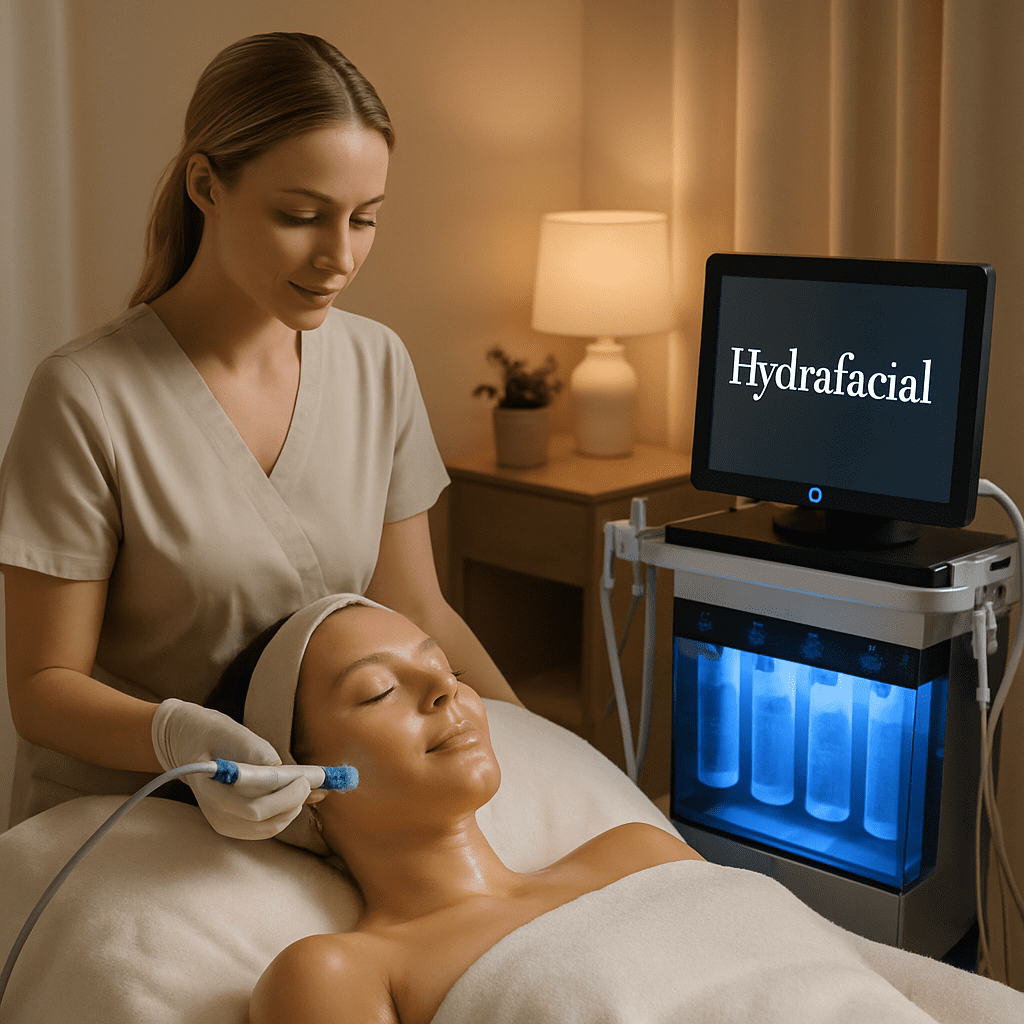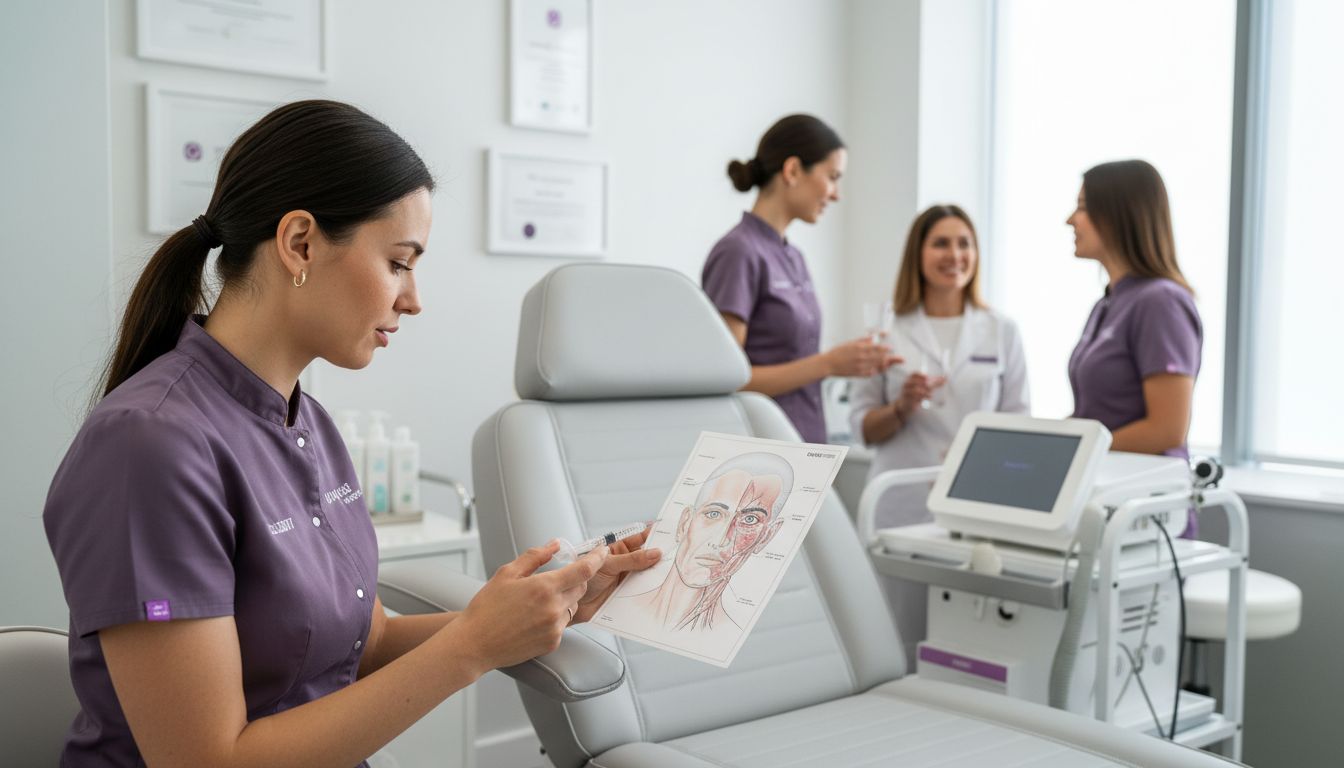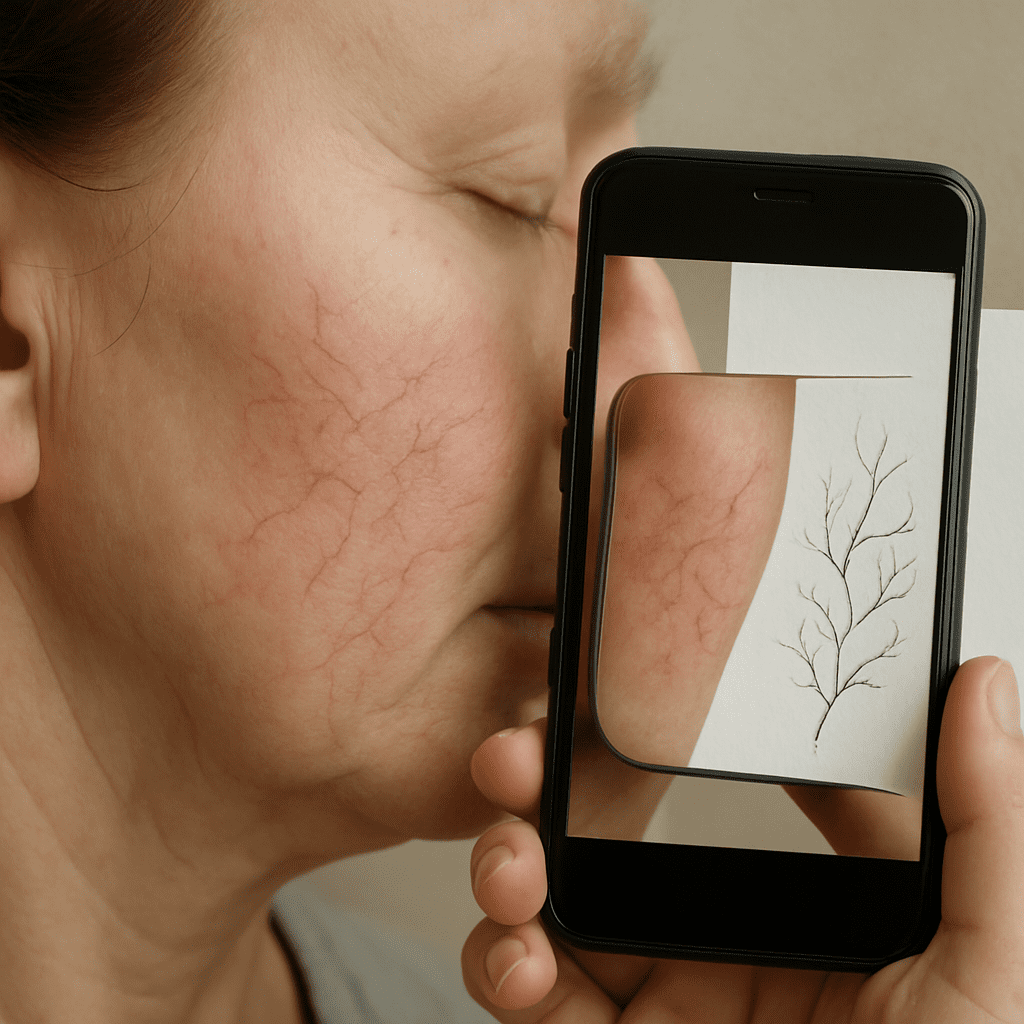Everyone wants skin that looks fresh, youthful, and vibrant. But with so many skin rejuvenation treatments out there, how do you decide what’s right for you? When it comes to improving skin texture, tone, and reducing wrinkles, two popular options often come up: chemical peels and microdermabrasion. So, which one should you choose?
At first glance, both treatments promise smoother, brighter skin. But their methods, downtime, and results can be quite different. Are you looking for a deeper exfoliation that targets stubborn pigmentation and wrinkles? Or maybe a gentler, non-invasive approach that refreshes your skin gradually? Understanding the key differences between chemical peel vs microdermabrasion can save you time, money, and frustration.
Here at Simcoe Cosmetic Clinic, we see a wide range of clients—from 20-year-olds aiming to maintain their youthful glow, to those in their 80s wanting to rejuvenate and smooth their skin without surgery. Whether you’re hunting for a quick glow-up before a big event or addressing long-term skin concerns like uneven tone or fine lines, knowing what each treatment offers will help you make a confident decision.
What makes a chemical peel different from microdermabrasion? How do you prepare, what does recovery look like, and what kind of results can you expect? We’ll tackle all that and more. Plus, you’ll get tips on when to consider combining treatments or opting for one over the other based on your unique skin type and goals.
If you’ve been curious about non-surgical skin rejuvenation options, this guide is for you. Dive deeper into our expert insights and make an informed choice that suits your lifestyle and skin health. Ready to unlock your best complexion? Let’s dive in and explore the benefits, processes, and differences of chemical peel vs microdermabrasion.
For those interested in a comprehensive skin renewal experience, check out our detailed article on chemical peel Barrie treatments to see how professional care can enhance your results.
TL;DR: Key Takeaways on Chemical Peel vs Microdermabrasion
Wondering which treatment suits your skin goals best? Chemical peels offer deeper exfoliation to target pigmentation and fine lines, while microdermabrasion gently resurfaces for instant brightness and texture improvement.
Both enhance your glow without surgery, but your skin type and downtime tolerance can help decide the right fit. Ready to refresh your look with expert guidance? Let’s help you choose wisely.
What Is a Chemical Peel? Types, Procedures, and Benefits
If you’ve been weighing the chemical peel vs microdermabrasion debate, it’s helpful to understand exactly what a chemical peel involves and why it might be the right choice for you. Simply put, a chemical peel is a skin-resurfacing procedure where a solution is applied to your skin to remove its outermost layers. As those dead skin layers shed, fresh, smoother, and more youthful skin appears underneath.
Sounds intriguing, right? But did you know chemical peels come in different depths and formulations tailored to your unique skin concerns? Let’s break it down so you can make an informed decision.
Types of Chemical Peels
Chemical peels generally fall into three categories: light, medium, and deep. Each varies in strength and recovery time, tackling different skin challenges.
- Light Peels: These use mild acids like alpha-hydroxy acid (AHA) or beta-hydroxy acid (BHA) to gently exfoliate the outer layer. Ideal for improving skin texture, mild sun damage, and fine wrinkles, they usually require multiple sessions for best results.
- Medium Peels: Using stronger agents such as trichloroacetic acid (TCA), medium peels reach deeper layers to treat age spots, wrinkles, and uneven pigmentation. Expect some redness and downtime, but the smoother, clearer skin payoff is worth it.
- Deep Peels: These are the heavy hitters. Penetrating the lower layers of skin, deep peels are reserved for severe sun damage, deep wrinkles, and scars. Recovery times are longer, but the dramatic improvements can be life-changing.
Beyond strength, formulations matter too. For example, PCA SKIN® chemical peels mix ingredients like lactic acid, salicylic acid, kojic acid, and sometimes hydroquinone to not only exfoliate but also brighten and even out pigmentation, making them great for sensitive or ethnic skin types prone to discoloration. If acne or redness like rosacea is a concern, specific peels can calm inflammation while smoothing skin.
How Does the Procedure Work?
During your visit to Simcoe Cosmetic Clinic, your skincare expert will first cleanse your face thoroughly. Then, the selected chemical solution is carefully applied to your skin — usually with a brush or cotton applicator.
Depending on the peel’s depth, you might feel some tingling or mild burning as the acids loosen the bonds between old skin cells. This process encourages peeling over the next few days, revealing new skin that’s brighter and fresher.
Light peels are often quick, outpatient treatments with minimal discomfort, letting you resume normal activities almost immediately. Medium to deep peels may require sedation or numbing agents and involve several days to weeks of recovery with redness, peeling, and meticulous aftercare.
Post-procedure care is critical. You’ll be advised to keep your skin moisturized, avoid sun exposure, and use gentle products to protect your healing skin. Your provider might also recommend special ointments or follow-up visits to monitor progress.
Benefits You Can Expect
Wondering why chemical peels are so popular here in Barrie and beyond? For starters, they effectively address:
- Wrinkles and fine lines: Peels stimulate collagen production, leading to firmer, smoother skin.
- Uneven skin tone and hyperpigmentation: Lightens dark spots including sun damage, melasma, and acne scars.
- Acne and acne scars: Helps unclog pores and reduce inflammation, revealing clearer skin.
- Overall texture and radiance: Removes dull, dead skin layers to reveal a glow you’ll love.
Unlike microdermabrasion, which mechanically exfoliates primarily the skin’s surface, chemical peels penetrate varying depths to trigger natural regeneration processes, leading to more noticeable and longer-lasting improvements. But keep in mind, deeper peels mean more downtime, so think about your lifestyle when choosing.
Curious how a chemical peel could fit into your skin rejuvenation goals? Our team at Simcoe Cosmetic Clinic tailors treatments based on your skin type, desired results, and tolerance for downtime, ensuring a safe and effective experience.
If you’re ready to take that next step toward fresher, younger-looking skin with expert guidance, understanding the nuances of chemical peels can help you decide if it’s the right route versus microdermabrasion treatments.
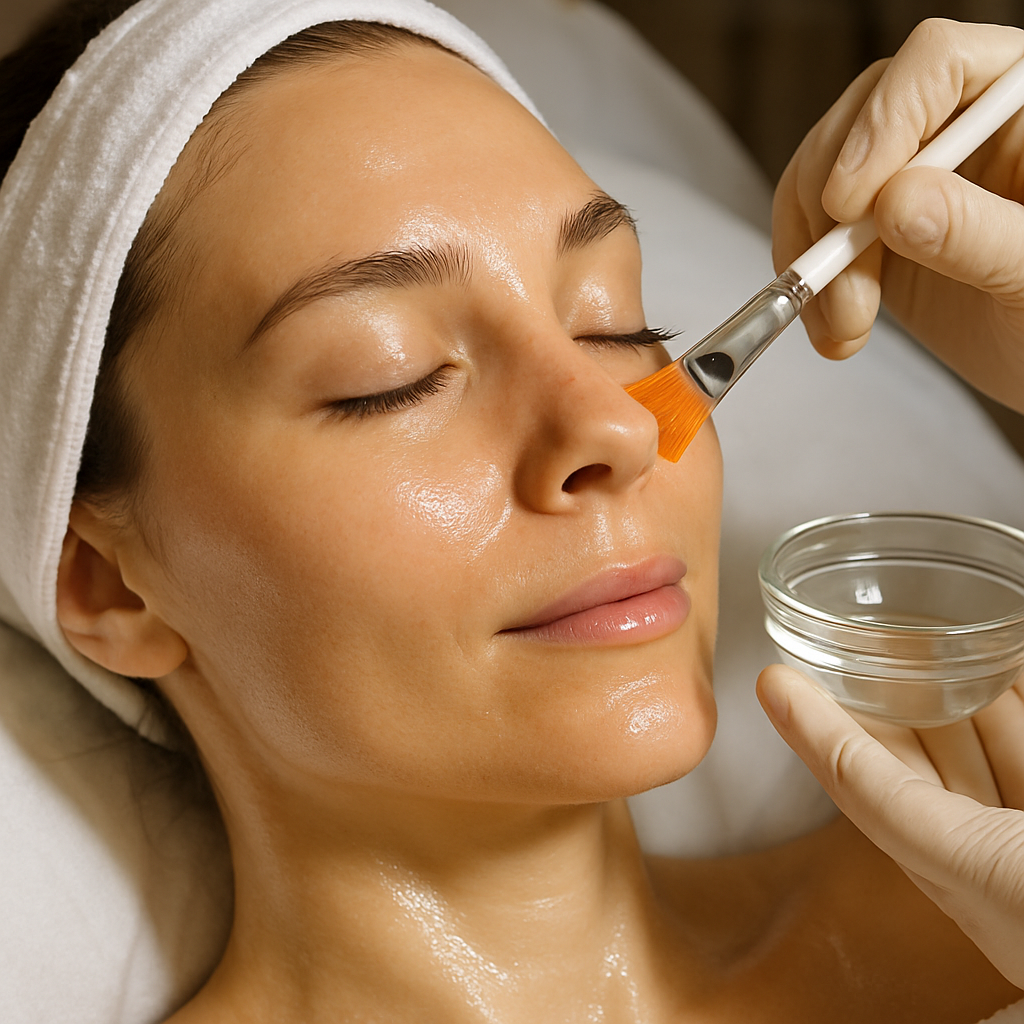
To learn more about how different chemical peel types match specific skin needs, check out the detailed explanations provided by the OHSU Cosmetic Plastic Services.
For a trusted overview of what to expect during and after your chemical peel, including care tips and potential side effects, explore insights from Mayo Clinic’s guide to chemical peels.
Understanding Microdermabrasion: How It Works and Skin Benefits
If you’re weighing the chemical peel vs microdermabrasion debate, it’s important to really understand what microdermabrasion is and how it can help your skin look its best. This popular treatment at Simcoe Cosmetic Clinic gently buffs away the outermost layer of your skin to reveal fresher, smoother skin underneath.
So, how exactly does this magic happen? Microdermabrasion is a minimally invasive procedure that uses a special device to exfoliate dead skin cells. Unlike chemical peels that rely on acids to chemically peel away layers of skin, microdermabrasion physically sands off just the surface—think of it as a gentle sanding for your face, neck, chest, or hands.
The two most common methods you’ll find are crystal microdermabrasion and diamond-tip microdermabrasion. Crystal microdermabrasion sprays tiny crystals onto the skin, which then get vacuumed along with dead skin. Diamond-tip microdermabrasion uses a diamond-coated wand to gently abrade dead skin cells. Both methods aim to polish your skin without causing major irritation or downtime, which is why this treatment is ideal if you want quick results without the fuss.
What does this mean for your skin? Regular microdermabrasion sessions can diminish the look of fine lines, uneven pigmentation, and mild sun damage. Plus, it softens rough patches and can reduce the appearance of minor scars and age spots. Many people notice their skin feels smoother after just one treatment, but the real benefits shine after multiple sessions that stimulate natural collagen production. You’ll gradually see a healthier, more youthful glow emerging.
Does this sound like what your skin needs? If your goal is subtle rejuvenation—or if you have sensitive skin that can’t tolerate aggressive treatments—microdermabrasion might be the perfect fit. It’s considered safe for nearly all skin types and tones, with minimal risks and downtime according to the Cleveland Clinic’s detailed explanation of microdermabrasion.
Here’s an inside tip: microdermabrasion doesn’t just exfoliate—it also boosts your skincare products’ effectiveness. By clearing away dead cells, your serums and moisturizers can penetrate deeper and work better, so it’s a win-win for maintaining glowing skin.
Wondering if the process is uncomfortable? Most clients report it feels like a light scratching or suction sensation, with no need for topical anesthetics. The procedure usually takes about 30 to 40 minutes, making it a convenient option for those with busy schedules. After treatment, your skin might be slightly pink or sensitive for up to 24 hours but recovers quickly, unlike chemical peels which can require more downtime.
It’s also worth noting that while microdermabrasion excels at refreshing surface skin, it isn’t designed to treat deep wrinkles or scars like some stronger options. If that’s a concern, your customized treatment plan at Simcoe Cosmetic Clinic might combine microdermabrasion with other therapies for enhanced results.
To get a better sense of what microdermabrasion looks like in action, check out this informative video:
Before deciding between a chemical peel vs microdermabrasion, consider your skin type, concerns, and lifestyle. Microdermabrasion offers a gentle, quick way to refresh your skin with very little recovery time. It’s a safe, affordable option for many clients looking for that youthful glow without the intensity of chemical exfoliation.
If you’re curious about how microdermabrasion could refresh your complexion or want to discuss which treatment matches your skin’s unique needs, our experts at Simcoe Cosmetic Clinic are here to guide you every step of the way.
For more medical insight into microdermabrasion’s benefits and process, the WebMD overview of microdermabrasion is an excellent resource. It highlights the safety and typical outcomes you can expect from this procedure.
Ready to take the next step? Learning about your options is the best way to make a confident choice for your skin health and glow.
Chemical Peel vs Microdermabrasion: A Side-by-Side Comparison
Choosing between a chemical peel vs microdermabrasion can feel tricky when you’re aiming for that radiant, youthful skin. Both treatments are popular at places like Simcoe Cosmetic Clinic, but they work quite differently and cater to slightly different skin needs. Let’s break down what each treatment involves, their pros and cons, and which might be best for your unique goals.
How Do They Work?
A chemical peel uses a specially formulated solution—think acids like glycolic, trichloroacetic, or phenol—that exfoliates by dissolving the top layers of damaged skin. The old skin peels away over days, revealing fresh, smoother skin underneath.
Microdermabrasion, on the other hand, is more like a gentle sanding. A handheld device with tiny crystals or diamond tips physically buff away the outermost dead skin cells without any chemicals. It’s a mechanical exfoliation rather than a chemical one.
Does that foundation help you see the first big difference? Chemical peels chemically stimulate skin renewal with greater depth, while microdermabrasion mechanically resurfaces skin with a lighter touch.
Who’s Each Treatment For?
Chemical peels are great if you want to tackle deeper skin concerns—things like sun damage, stubborn wrinkles, acne scars, or pigmentation issues that need a stronger approach. They’re often favored by those ready for a more dramatic refresh, and they can deliver longer-lasting results.
Microdermabrasion suits those seeking a gentler option. If you have sensitive skin or need something with little to no downtime, this might be your go-to. It’s excellent for mild discoloration, uneven texture, and keeping the skin’s glow in tip-top shape with regular sessions.
Still wondering which fits your skin story best? Believe it or not, many clients combine both treatments to enjoy layered benefits, tailored specifically to their skin’s quirks and goals.
Downtime and Side Effects
This is a biggie: chemical peels, especially the medium to deep types, generally require some downtime. After the procedure, expect peeling, redness, maybe some swelling, lasting days to weeks depending on the peel’s strength. Protecting your skin from the sun becomes a must to avoid pigmentation issues.
Microdermabrasion, by contrast, offers minimal side effects—usually just a bit of redness or tightness that disappears quickly. You typically bounce back right away, making it perfect if your schedule is hectic.
But remember, chemical peels carry a higher risk of complications like scarring or pigmentation changes, particularly on darker skin tones, so proper consultation is vital before moving forward.
Results and Longevity
Here’s where the investment speaks volumes. Chemical peels can provide dramatic improvements lasting months or even years with good care, including diligent sunscreen use. You’ll notice smoother, firmer skin and reduction in wrinkles or pigmentation.
Microdermabrasion requires multiple sessions—often six to twelve spaced a week or two apart—to achieve visible results. Then, maintenance treatments keep your skin glowing. Effects are subtle but cumulative, making it a wonderful option for gradual refinement.
Ask yourself: do you prefer a quick reset with a longer payoff, or ongoing gentle polishing to keep your complexion bright?
Cost Considerations
Chemical peels tend to be pricier due to their complexity, requiring expert administration and sometimes anesthesia for deeper peels. Average costs can hover around $750-$850 per session.
Microdermabrasion is generally more budget-friendly, with sessions around $150 or so. Because it demands regular repetition, the total cost adds up, but each individual session remains accessible.
For many, the choice also depends on the balance between budget, desired results, and tolerance for downtime.
Summary Table: Chemical Peel vs Microdermabrasion
| Feature | Chemical Peel | Microdermabrasion |
|---|---|---|
| Method | Chemical solution exfoliates and dissolves skin layers | Mechanical exfoliation using crystals or diamond tip device |
| Best For | Wrinkles, sun damage, acne scars, pigmentation | Mild discoloration, uneven texture, minor scarring |
| Downtime | Moderate to high (peeling, redness 1-3 weeks) | Minimal (redness or tightness lasts hours) |
| Sessions Needed | Fewer sessions, sometimes one deep peel | Multiple sessions (6-12) with maintenance |
| Longevity of Results | Months to years with good care | Short-term, cumulative over multiple sessions |
| Cost per Session | $750-$850 average | Around $150 average |
At Simcoe Cosmetic Clinic, we tailor treatments to each client after considering your skin type, lifestyle, and goals, ensuring you receive the best path to brighter, healthier skin. Don’t hesitate to ask which option aligns best with your expectations and tolerance for downtime.
Want to delve deeper into how these treatments work? The detailed comparison at Diffen offers extensive insights, while the Cleveland Clinic’s guide on wrinkle treatments helps put things into perspective. Also, for those new to microdermabrasion, this WebMD overview clarifies what to expect during the procedure.
Choosing between a chemical peel vs microdermabrasion boils down to your skin’s needs, tolerance for recovery, and how quickly you want to see results. Either way, expert support and a customized approach make all the difference in your skin rejuvenation journey.
Choosing the Right Treatment for Your Skin Type and Concerns
When it comes to deciding between a chemical peel vs microdermabrasion, understanding your unique skin type and specific concerns is absolutely key. There isn’t a one-size-fits-all answer here, but the better you know your skin, the easier it is to pick the right treatment.
Consider Your Skin Type
Do you have oily, dry, sensitive, or combination skin? Each reacts differently to exfoliating treatments. For example, if your skin is dry or sensitive, microdermabrasion is often a gentler option since it only removes the outermost layer of dead skin without using strong chemicals. In contrast, chemical peels penetrate deeper, which can be fantastic for resurfacing but might cause irritation or downtime for sensitive skin.
People with oily or acne-prone skin might find that chemical peels better target clogged pores and reduce acne scars by promoting new collagen growth. Those struggling with hyperpigmentation, sun damage, or deeper wrinkles often see more dramatic results with a chemical peel.
Match Treatment to Your Skin Concerns
Are fine lines or uneven skin tone your main worry? Microdermabrasion can gently polish your skin, improving texture and brightness over multiple sessions. If deeper flaws like pronounced wrinkles, dark spots, or acne scars bother you, a chemical peel typically provides a more powerful solution, peeling back damaged skin layers to reveal fresher skin underneath.
Keep in mind that chemical peels often require some downtime depending on the strength used, while microdermabrasion usually has minimal recovery time. This might influence your choice if fitting your treatment around your lifestyle and social plans.
Take Preparation and Aftercare Seriously
No matter which path you choose, prepping your skin and following expert aftercare can make all the difference. For instance, avoiding excessive sun exposure before and after a chemical peel is crucial to prevent complications like irritation or pigmentation issues. You’ll want to keep your skin hydrated and protected with suitable moisturizers and sunscreen tailored to your skin type — something especially important after exfoliation treatments.
Where to Begin?
Still unsure? At Simcoe Cosmetic Clinic, we never recommend guessing. Our experienced team assesses your skin thoroughly to guide you towards the safest and most effective choice—be it microdermabrasion or a chemical peel. Personalized consultation ensures you get results that match your goals without unnecessary risks.
To get a sharper idea of what suits your skin, you can explore an expert comparison on how treatments perform for different skin concerns. Also, understanding how to care for dry or sensitive skin before and after procedures is vital; consider insights from the Mayo Clinic’s advice on managing dry skin effectively.
Choosing the right treatment isn’t just about the procedure itself; it’s also about what fits your lifestyle and how much downtime you can tolerate. If you want no-fuss, minimal recovery and subtle skin renewal, microdermabrasion might be ideal. But if you’re aiming for deeper resurfacing with longer-lasting results, a chemical peel could be worth the extra effort and healing time.
Ready to take the next step? Scheduling a professional skin evaluation at Simcoe Cosmetic Clinic can help tailor a plan perfect for your skin’s needs and your aesthetic goals. Plus, you can learn about other rejuvenating options, like microneedling in Barrie, which can complement or even enhance your chosen exfoliation treatment.
Remember, your skin is unique, and choosing the right treatment is an investment in your confidence and health. Don’t settle for one-size-fits-all; work with experts who listen, assess, and recommend based on real skin science and your individual goals.
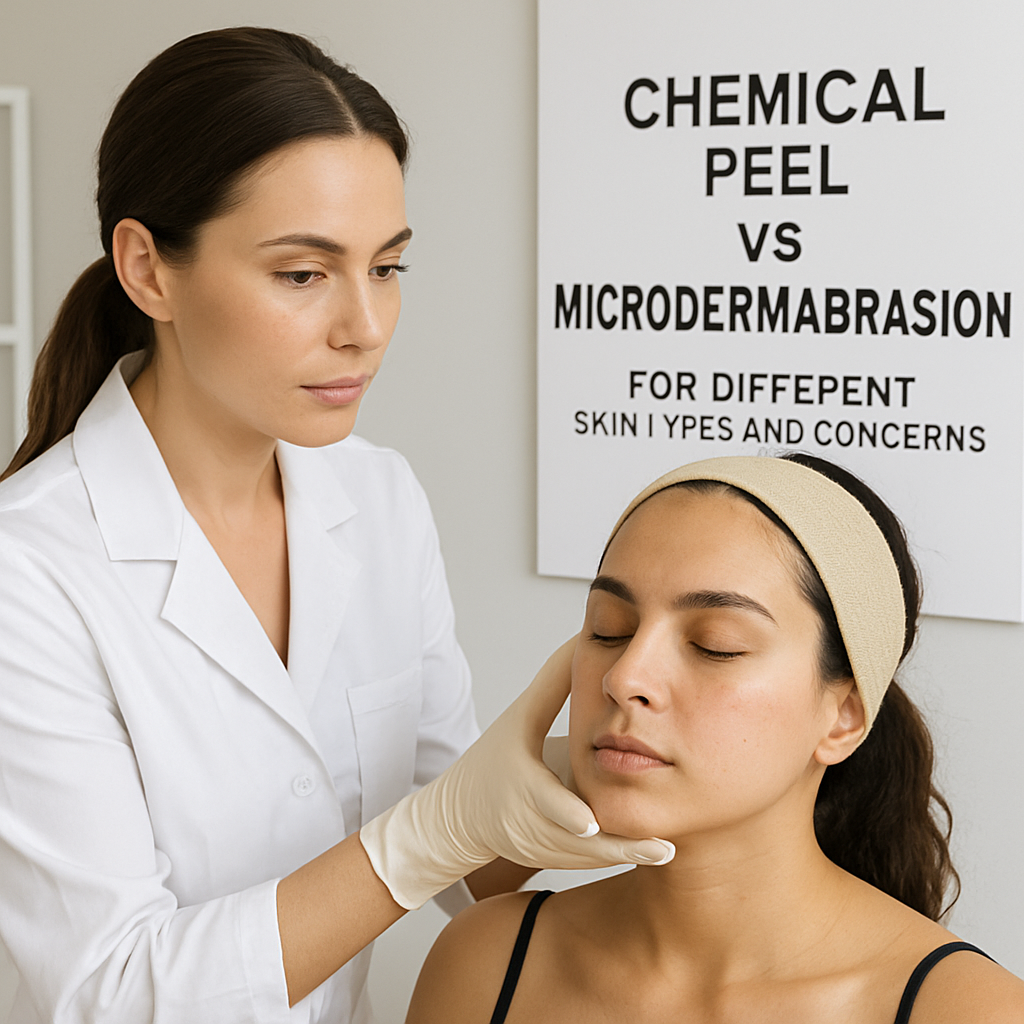
Preparation, Aftercare, and What to Expect Post-Treatment
When navigating the choice between a chemical peel vs microdermabrasion at Simcoe Cosmetic Clinic, one critical aspect is understanding how to prepare for each treatment and care for your skin afterward. Proper preparation and aftercare not only boost your results but also protect your skin’s health during its healing journey.
Preparing Your Skin: Setting the Stage for Success
For chemical peels, your practitioner will likely advise you to halt the use of retinols, exfoliating agents, and tanning products at least a week before your appointment. This helps reduce skin sensitivity and lowers the risk of complications. Avoid excessive sun exposure in the days leading up to your peel—your skin should be in a calm, uninflamed state to maximize the benefits.
Microdermabrasion is gentler but still requires some prep. You’ll want to avoid tanning, waxing, and the use of harsh exfoliants a few days before your session. Cleansing your face thoroughly and skipping makeup on treatment day ensures your skin is pristine for the procedure.
What Happens Immediately After the Procedure?
One great thing about microdermabrasion is there’s virtually no downtime. You may notice a mild redness or slight tenderness, which usually fades within a few hours. This means you can jump right back into your day without interruption.
Chemical peels are more intensive. Expect some peeling, dryness, and increased sun sensitivity in the days following your treatment. Your skin is actively shedding old layers to reveal fresh, renewed skin underneath. This process varies depending on the peel’s strength but generally requires careful attention and patience.
Aftercare Tips: Protect and Nourish Your New Skin
Do not underestimate the power of sun protection. Chemical peels especially make your skin vulnerable—slather on a broad-spectrum sunscreen with at least SPF 30, and stay out of direct sunlight as much as possible for six weeks post-treatment. Incorporating sunscreen as a daily habit protects your investment and prevents pigmentation issues.
Switch to gentle, soap-free cleansers and moisturizers designed for sensitive skin after either procedure. Avoid scrubs, retinoids, and exfoliants until your practitioner gives the green light—pushing your skin too hard can lead to irritation or extended healing time. Cooling your skin with lukewarm water and patting dry gently soothes sensitivity and inflammation.
And remember: Don’t peel or pick at your skin after a chemical peel, even if the temptation is strong. Letting your skin shed naturally prevents scarring and infection.
Wondering how long you should wait between treatments? Many experts suggest spacing chemical peels several weeks apart to allow your skin to fully recover, while microdermabrasion sessions can be scheduled more frequently, typically every few weeks, depending on your desired results and skin response.
Does This Sound Like A Lot? You’re Not Alone.
Preparation and aftercare might seem demanding, but consider how much you invest in your skin’s future every time you choose professional treatments. Following the right guidelines ensures your skin looks its best, longer. For tailored advice and a plan that respects your lifestyle and skin type, booking a consultation with Simcoe Cosmetic Clinic’s specialists is the smartest way forward.
For a detailed overview of chemical peel care, Glowday’s chemical peel aftercare guide breaks down the do’s and don’ts to keep your skin radiant.
Want to learn more about microdermabrasion’s safety and post-treatment expectations? Healthline’s microdermabrasion overview offers expert insights on recovery and what to expect.
Risks, Side Effects, and When to Avoid These Treatments
When weighing the options in the chemical peel vs microdermabrasion debate, understanding the risks and side effects of each is key to making a safe choice for your skin.
What Risks Should You Know Before Booking?
Chemical peels intentionally damage the outer skin layers to trigger renewal, which means side effects can sometimes be more intense. You might experience redness, swelling, and even blistering shortly after treatment. These symptoms usually subside within days to a couple of weeks, depending on the peel depth.
In more serious cases, especially with medium or deep peels, complications like scarring, infection, or changes in skin pigmentation can occur. This is why chemical peels require careful patient selection, and why darker skin tones or sensitive skin types should approach deep peels with caution. People with active skin infections, open wounds, or recent use of certain medications like isotretinoin should avoid these treatments altogether.
On the flip side, microdermabrasion is considered gentler, with common side effects being temporary redness, mild swelling, and dry, flaky skin lasting just a few days. Because it’s less invasive, the risks of scarring or pigmentation changes are significantly lower, making microdermabrasion a preferred option for many looking for more frequent maintenance with minimal downtime.
When Should You Say No?
If you’re pregnant, have a history of herpes simplex outbreaks, or are currently dealing with acne flare-ups or eczema, it’s smart to postpone chemical peels and microdermabrasion until your skin calms down. Additionally, avoiding these treatments if you’ve recently had other skin procedures or excessive sun exposure can help prevent unwanted complications.
Wondering how to protect your skin post-treatment? You must avoid direct sun exposure and always use a broad-spectrum sunscreen. This simple step reduces the chance of hyperpigmentation and supports proper healing after either chemical peels or microdermabrasion.
Want a deeper dive into chemical peel side effects and safety? Check out the detailed guide from National Library of Medicine on chemical peel risks. For a thorough look at microdermabrasion safety and typical side effects, The American Society of Plastic Surgeons offers expert insights on microdermabrasion.
So, which treatment fits you? Consider your skin type, tolerance for downtime, and overall goals. When in doubt, a consultation with the experts at Simcoe Cosmetic Clinic can help you make the safest, most effective choice for younger, healthier-looking skin.
Frequently Asked Questions About Chemical Peel vs Microdermabrasion
If you’ve been weighing chemical peel vs microdermabrasion, you’re not alone in having tons of questions. These are two of the most popular skin rejuvenation treatments at Simcoe Cosmetic Clinic, and it’s only natural to want the scoop before booking your appointment.
1. What’s the main difference between chemical peels and microdermabrasion?
Chemical peels use specialized acids to remove the outer layers of your skin, revealing fresher, smoother skin underneath. Microdermabrasion, on the other hand, gently exfoliates the skin using tiny crystals or a diamond tip to slough off dead skin cells. Think of peels as a chemical exfoliation and microdermabrasion as a physical one.
2. Which treatment is better for sensitive skin?
Got sensitive skin? Microdermabrasion is usually a gentler option with minimal irritation. Chemical peels can be customized with milder acids, but there’s a higher chance of redness or peeling afterwards.
3. How long does each treatment take and how soon can I return to my daily activities?
Microdermabrasion sessions are quick—typically about 30 minutes—with almost no downtime. You can often get back to your routine immediately. Chemical peels vary: lighter peels have minimal recovery, but medium to deep peels might require days to weeks of healing.
4. Can chemical peels or microdermabrasion treat acne scars and sun damage?
Yes! Chemical peels are particularly effective at reducing discoloration, sunspots, and some acne scars by encouraging new skin growth. Microdermabrasion can improve mild scarring and texture but usually requires multiple sessions for noticeable results.
5. How many treatments will I need?
This depends on your skin goals. Many people opt for monthly microdermabrasion maintenance. Chemical peels might be spaced out every few months, especially deeper types. Your skin’s response and desired results guide the treatment frequency.
6. Are there any risks I should be aware of?
Both treatments are safe when done by experts. Chemical peels carry a slight risk of prolonged redness, peeling, or pigmentation changes if aftercare isn’t followed. Microdermabrasion is low risk but might cause mild redness or sensitivity immediately after treatment.
7. How should I care for my skin after these treatments?
Post-treatment, your skin needs gentle care. Avoid sun exposure and apply a broad-spectrum sunscreen diligently. Use gentle, hydrating skincare products and stay away from exfoliants or harsh ingredients until your skin fully heals.
Still unsure which treatment suits your unique skin? The best next step is a personalized consultation at Simcoe Cosmetic Clinic. We’ll assess your skin type, concerns, and lifestyle to help you confidently choose between chemical peel vs microdermabrasion—and tailor a plan for radiant, younger-looking skin.
Conclusion: Making an Informed Choice for Radiant Skin
Choosing between a chemical peel and microdermabrasion isn’t just about picking a popular treatment—it’s about understanding what your skin truly needs. Both procedures offer remarkable benefits, but they work differently and suit different skin types and concerns.
Ask yourself: Are you looking for a deep exfoliation that can tackle discoloration and reveal fresher skin beneath? Or would you prefer a gentler approach that improves texture over time without much downtime? Remember, the right choice depends on your unique skin goals, lifestyle, and tolerance for recovery.
At Simcoe Cosmetic Clinic, we believe personalized care makes all the difference. Our experts assess your skin health, discuss your concerns, and recommend a treatment plan that aligns with your vision of radiant, youthful skin. Whether it’s the controlled intensity of chemical peels or the subtle refinement of microdermabrasion, you’ll get a tailored approach designed just for you.
Don’t hesitate to schedule a consultation if you’re still weighing the chemical peel vs microdermabrasion debate. After all, informed decisions lead to better results—and happier skin.
Ready to take the next step? Your journey to glowing skin starts with expert guidance and a plan that fits your lifestyle. Let’s make it happen together.

